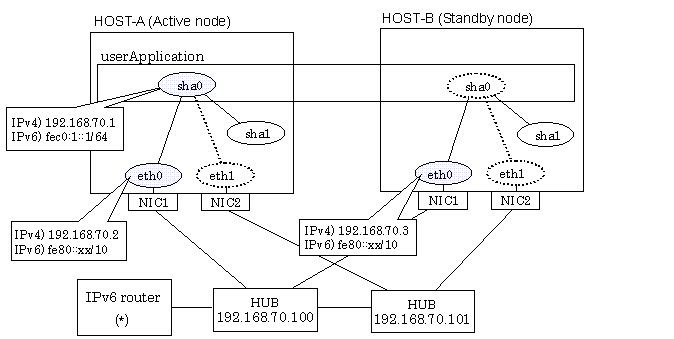

| PRIMECLUSTER Global Link Services Configuration and Administration Guide: Redundant Line Control Function 4.1 (for Linux) |
Contents
Index
 
|
| Appendix B Examples of configuring system environments | > B.6 Example of configuring NIC switching mode (IPv4/IPv6) |
This section describes an example configuration procedure of the network shown in the diagram below.
The xx in the figure below are assigned automatically by the automatic address configuration.
For the network configuration other than GLS, refer to "3.2.2 Network configuration".
For configuring the cluster system, refer to the Cluster system manual.
In this section, description of private LAN is omitted.
The dotted line indicates that the interface is inactive.


For configuring Linux server to use as IPv6 router, refer to "B.5.1 Example of the Single system without NIC sharing". The following is an example of configuring /etc/radvd.conf of the figure above. For details on /etc/radvd.conf, refer to radvd.conf(5) manual. In addition, do not configure radvd on the server running NIC switching mode.
interface eth0
{
AdvSendAdvert on; # Sending router advertisements
MinRtrAdvInterval 3;
MaxRtrAdvInterval 10;
prefix fec0:1::0/64 # Sending Prefix fec0:1::0/64 from eth0
{
AdvOnLink on;
AdvAutonomous on;
AdvRouterAddr on;
};
}; |
1-1) Define IP addresses and hostnames in /etc/inet/hosts file. Note that it is not necessary to define an IPv6 address, which automatically allocates address by the Stateless Address Autoconfiguration feature.
192.168.70.1 hosta # HOST-A/B Takeover virtual IP 192.168.70.2 host11 # HOST-A Physical IP 192.168.70.3 host21 # HOST-B Physical IP 192.168.70.100 swhub1 # Primary HUB IP 192.168.70.101 swhub2 # Secondary HUB IP fec0:1::1 v6hosta1 # HOST-A/B Takeover virtual IP |
1-2) Configure /etc/sysconfig/network-scripts/ifcfg-ethX (X is 0,1) file as follows.
- Contents of /etc/sysconfig/network-scripts/ifcfg-eth0
|
DEVICE=eth0 |
- Contents of /etc/sysconfig/network-scripts/ifcfg-eth1
|
DEVICE=eth1 |
1-3) On the /etc/sysconfig/network file, define a statement which enables the network configuration.
|
NETWORKING=yes |
Run the following command and reboot the system. After rebooting the system, verify eth0 is enabled as an IPv4/IPv6 interface using ifconfig command.
/sbin/shutdown -r now
/opt/FJSVhanet/usr/sbin/hanetmask create -i 192.168.70.0 -m 255.255.255.0
/opt/FJSVhanet/usr/sbin/hanetconfig create -n sha0 -m d -i 192.168.70.1 -e 192.168.70.2 -t eth0,eth1

Ensure that the physical IP address specified using option '-e' is the same IP address configured in /etc/sysconfig/network-scripts/ifcfg-eth0.
/opt/FJSVhanet/usr/sbin/hanetconfig create inet6 -n sha0 -m d -i fec0:1::1/64 -t eth0,eth1
/opt/FJSVhanet/usr/sbin/hanetpoll create -n sha0 -p 192.168.70.100,192.168.70.101 -b off
/opt/FJSVhanet/usr/sbin/hanetconfig create -n sha1 -m p -t sha0
/opt/FJSVhanet/usr/sbin/hanethvrsc create -n sha0
/opt/FJSVhanet/usr/sbin/hanetpoll on
/opt/FJSVhanet/usr/sbin/strptl -n sha1
1-1) Define IP addresses and hostnames in /etc/inet/hosts file. Defined content is same as HOST-A.
1-2) Configure /etc/sysconfig/network-scripts/ifcfg-ethX (X is 0,1) file as follows.
- Contents of /etc/sysconfig/network-scripts/ifcfg-eth0
|
DEVICE=eth0 |
- Contents of /etc/sysconfig/network-scripts/ifcfg-eth1
|
DEVICE=eth1 |
1-3) On the /etc/sysconfig/network file, define a statement which enables the network configuration.
|
NETWORKING=yes |
Run the following command and reboot the system. After rebooting the system, verify eth0 is enabled as an IPv4/IPv6 interface using ifconfig command.
/sbin/shutdown -r now
/opt/FJSVhanet/usr/sbin/hanetmask create -i 192.168.70.0 -m 255.255.255.0
/opt/FJSVhanet/usr/sbin/hanetconfig create -n sha0 -m d -i 192.168.70.1 -e 192.168.70.3 -t eth0,eth1

Ensure that the physical IP address specified using option '-e' is the same IP address configured in /etc/sysconfig/network-scripts/ifcfg-eth0.
/opt/FJSVhanet/usr/sbin/hanetconfig create inet6 -n sha0 -m d -i fec0:1::1/64 -t eth0,eth1
/opt/FJSVhanet/usr/sbin/hanetpoll create -n sha0 -p 192.168.70.100,192.168.70.101 -b off
/opt/FJSVhanet/usr/sbin/hanetconfig create -n sha1 -m p -t sha0
/opt/FJSVhanet/usr/sbin/hanethvrsc create -n sha0
/opt/FJSVhanet/usr/sbin/hanetpoll on
/opt/FJSVhanet/usr/sbin/strptl -n sha1
After configuring HOST-A and HOST-B, register the created takeover virtual interface as a Gls resource to create a cluster application. Use RMS Wizard to set up the cluster configuration. For details, see "PRIMECLUSTER Installation and Administration Guide 4.1".
After completing the configuration, start the userApplication to activate the takeover virtual interface on the operation node.
Contents
Index
 
|